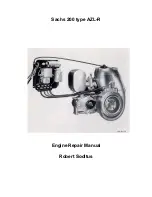
6
INSTALLATION AND MAINTENANCE
CPLS drip-proof 3-phase induction motors
4240 en - 2014.09 / b
LEROY-SOMER
2.2 - Location
Motors in the CPLS range are IP23 motors. They must therefore
be installed under shelter so they are not to exposed to bad
weather.
The standard cooling mode for these motors is IC06 in
accordance with standard EN 60034-6. In other words, the
coolant is taken from and expelled into the surrounding
medium, and this fluid circulates thanks to a system independent
of the motor speed.
The following recommendations must therefore be observed:
The motor must be installed in a ventilated place, with clearance
for the air inlet and outlet.
Obstruction (clogging) - even accidental - of the ventilation
circuit has an adverse effect on motor operation.
It is also necessary to check that hot air is not being recycled.
If it is, pipes must be provided for the intake of cold air and/or
discharge of hot air, in order to prevent abnormal motor
temperature rise.
Unless otherwise stated at the time of ordering, the motor is
sized for a standard environment in accordance with
EN 60034-1, in other words:
- Altitude 1000 m or less
- Temperature b5 and +40°C
For ease of servicing, ensure access to the motor terminal
boxes and inspection doors is unobstructed.
The motor must be fixed on a flat surface which is rigid enough
to prevent distortion and vibration.
The seals should be able to withstand the forces engaged
during normal motor operation, as well as a possible overtorque
of at least twice the machine’s rated torque.
For the CPLS motor range, the standard
mounting positions are B3 and B35. Mounting
position B5 is prohibited. Contact Leroy-Somer for any
other mounting position.
The motor is fitted with lifting rings mounted diagonally on each
end shield.
They are designed tolift
the motor only
and must not be used
to lift the whole machine after the motor has been fitted to it.
If necessary, use a lifting bar system to
avoid damaging the forced ventilation
unit and its accessories.
Note: Never stand on the motor.
2.3 - Coupling
Preparation
Turn the motor by hand before coupling
to detect any possible fault due to
handling.
Remove any protection from the shaft
extension.
Moving the motor
For made-to-order motors with roller bearings, if the motor has
to be moved after the coupling device has been fitted, the rotor
must be immobilised.
Summary of Contents for CPLS 112
Page 27: ......







































